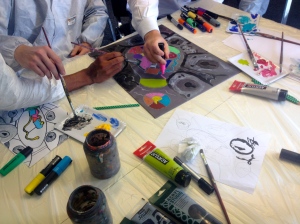A number of provocative challenges are shared within the group:
- “Risk means balancing between fear and courage, I went out of balance and that’s why I’m here today.”
- “I struggle to manage my multiple identities: father, husband, employer and biker.”
- “I spend every day taking care of my grandchildren and I’m not sure who’s leading whom.”
- “I’m getting married this weekend and wonder how it will affect my identity.”
- “At the moment my life is in transition and I realize that I don’t want to have to push to make change happen anymore.”
- "I’m at a crossroads and have lots of ideas about what’s next – the most difficult thing with this is the freedom to make the right choice.”
As the facilitator, I'm very conscious of navigating the tension between time and conversation – mindful of those who become frustrated by the exploration period of the discussion and jump to finding “solutions”.
We wrestle the diversity of issues down to three key topics and three groups who want to dive into them.
1. How do I Balance the tension between courage, fear and energy?
2. How do I exercise leadership by letting-go?
3. What drives my creative discovery and curiosity?
We all pick up on a sense of excitement, anticipation and inspiration unfolding. ...I’m relieved to see my trusty assistant arrive exactly on cue pushing a trolley brimming with fresh nibbles and drinks. The next 45 minutes bubble with to-ing and fro-ing between working through ideas in various parts of the museum (munching sun kissed cherries, hummus dipped pita, cheese and nuts) discussion, collaboration and keys to new questions.
The learning each group propose surprise, enlighten and inspire us all:
----------
- Leadership is about knowing the boundaries of resilience and courage - it’s a fluid state of holding the equilibrium within the tension.
- Improvisation or learning through living and giving of one’s self, is an expression of leadership.
- Moving away from the wanting mindset into a being one – means no longer “pushing” to make change happen.
Finding meaning
----------
After the hearty good-bye’s and well wishes, I’m left to muse over the 1st pilot Co.Llab. Finding common threads to create meaning was one of my expectations, all participants came into the Co.Llab with their own understanding of Leadership. Perception is very personal, as each individuals expression of being relates to our identity, context and environment.
During the Co.Llab each person was able to test their own ability to open to uncertainty, listen to and trust each other through dialogue and conversation. This expression is what makes Co.Llabs such unique spaces for learning and breakthrough thinking.
The more we practice, experience and test our understanding and embodiment of leadership, the greater the depth we create in our identity and its expression.
Work-in-progress takes on new meaning.





